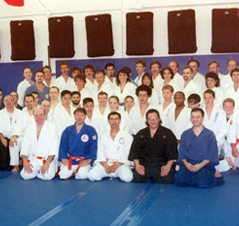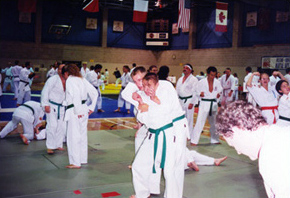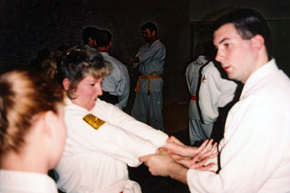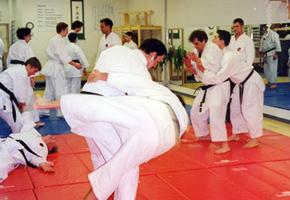|
Transmission of Knowledge
|
Fujiyama Dojo P.O. Box 20003 Thorold, ON, Canada L2V 5B3 (905) 680-6389 |
|---|
 Flowers scattering the water we thirst for far off, in the mist." - Issa
This haiku, written by the poet Kobayashi Yataro (Issa) has been named The Hungry Ghosts, and it is part of a rensakushi (a group of haiku on the same subject) called "The Six Ways". Although the group's topic is "the six forms of existence", Issa himself referred to this particular haiku as to be about "the unattainable". The image that the poem brings to mind can hardly relate to a Martial Arts seminar, one might say, where mostly every activity is upbeat, with a sweat-drenching pace that produces a natural "high", and a sense of accomplishment. And that might be the case, indeed. But the poem was brought out to reflect upon the reasons and aims of a seminar, which may not always be within the teacher's reach.
A brief look at Budo traditions may help to illustrate the point.
Most budoka are aware that a formal Embukai, as kept by traditional organizations, is composed of three main sections: Kouen, or lecture; Taikai, or meeting (where the actual training takes place); and Tenjikai (small artistic show). This pattern follows, and honors, the instructional format from the pre-Meiji clans' martial schools, such as the Nisshinkan, Kitagakukan, Yokendo, and others. Each section stands for a type of martial instruction.
The Kouen stands for the teachings of Shurei (study of etiquette and proper manners), Kokugaku (study of Japanese classic literature), Rogaku (study of Confucianism) and Egaku (healing sciences). Today, it is used for the study of Budo etiquette, Budo history, philosophy, and related topics. Flowers scattering the water we thirst for far off, in the mist." - Issa
This haiku, written by the poet Kobayashi Yataro (Issa) has been named The Hungry Ghosts, and it is part of a rensakushi (a group of haiku on the same subject) called "The Six Ways". Although the group's topic is "the six forms of existence", Issa himself referred to this particular haiku as to be about "the unattainable". The image that the poem brings to mind can hardly relate to a Martial Arts seminar, one might say, where mostly every activity is upbeat, with a sweat-drenching pace that produces a natural "high", and a sense of accomplishment. And that might be the case, indeed. But the poem was brought out to reflect upon the reasons and aims of a seminar, which may not always be within the teacher's reach.
A brief look at Budo traditions may help to illustrate the point.
Most budoka are aware that a formal Embukai, as kept by traditional organizations, is composed of three main sections: Kouen, or lecture; Taikai, or meeting (where the actual training takes place); and Tenjikai (small artistic show). This pattern follows, and honors, the instructional format from the pre-Meiji clans' martial schools, such as the Nisshinkan, Kitagakukan, Yokendo, and others. Each section stands for a type of martial instruction.
The Kouen stands for the teachings of Shurei (study of etiquette and proper manners), Kokugaku (study of Japanese classic literature), Rogaku (study of Confucianism) and Egaku (healing sciences). Today, it is used for the study of Budo etiquette, Budo history, philosophy, and related topics.
 The Taikai stands for the teaching of Bugei, or the actual techniques and strategy (Heiho). And the Tenjikai, or artistic display, stands for the time dedicated to Kowaka (dances which reenact inspirational military tales), which later included more varied forms of Bijutsu (arts), like koto, shamisen and shakahachi music, etc. Today, it may be done much in the same way, displaying traditional Japanese arts, like Taiko drums, fragments of No theatre, such as the beautiful "Ebira" ("Quiver"), etc. (religious rituals aside).
Most budoka also know that the Pre-Meiji formal instructional sessions were not conducted in the rigid, Western-style military manner, with its barked out orders and frequent posturing, that has become the current stereotype. This militaristic attitude appeared in the Meiji era, flourished during the Taisho, and became firmly established by the Showa era, but, as author Shiba Ryotaro once joked, "it (the militaristic posturing) has more to do with butter than with Bushido" (referring to its "imported" origin). In the early 1870's, Imperial Army and Navy officer students were sent around the world to study military systems, especially to Germany, where Prussian militarists greatly impressed the Japanese government, and to England, whose Royal Navy became the model after which the Japanese Imperial Navy was developed. The information they brought back spilled over into many areas of Japanese culture. The martial arts were by no means exempted from this influence.
However, even though the Pre-Meiji traditional training sessions had very little in common, fortunately, with the teaching style later used in the Army and Naval Academies, for example, discipline was strongly upheld by means of observing the rules of conduct (manners) and etiquette. These manners dictated that the teacher should teach in a measured, quiet voice and still be heard. Also, speaking with a vociferous tone, and exaggerated gesturing at any time, by either teachers or students, was considered to be highly offensive and unbecoming. So we must not think that raucous behavior is tolerated. Respect and courtesy was the proper atmosphere.
Another fact we must mention is that students were there to learn, to absorb every bit of knowledge and wisdom that the teachers offered, with great appreciation. As Shiba Goro (a former Nisshinkan student who served in the Russo-Japanese War) remarked, he would write everything his teachers would say during class "so not a single one of my teachers' words would be forgotten, for it would be to my shame if they wasted their time for my sake." (This quote is a paraphrase of the Makoto no Kokoro text on samurai ethics.) The Taikai stands for the teaching of Bugei, or the actual techniques and strategy (Heiho). And the Tenjikai, or artistic display, stands for the time dedicated to Kowaka (dances which reenact inspirational military tales), which later included more varied forms of Bijutsu (arts), like koto, shamisen and shakahachi music, etc. Today, it may be done much in the same way, displaying traditional Japanese arts, like Taiko drums, fragments of No theatre, such as the beautiful "Ebira" ("Quiver"), etc. (religious rituals aside).
Most budoka also know that the Pre-Meiji formal instructional sessions were not conducted in the rigid, Western-style military manner, with its barked out orders and frequent posturing, that has become the current stereotype. This militaristic attitude appeared in the Meiji era, flourished during the Taisho, and became firmly established by the Showa era, but, as author Shiba Ryotaro once joked, "it (the militaristic posturing) has more to do with butter than with Bushido" (referring to its "imported" origin). In the early 1870's, Imperial Army and Navy officer students were sent around the world to study military systems, especially to Germany, where Prussian militarists greatly impressed the Japanese government, and to England, whose Royal Navy became the model after which the Japanese Imperial Navy was developed. The information they brought back spilled over into many areas of Japanese culture. The martial arts were by no means exempted from this influence.
However, even though the Pre-Meiji traditional training sessions had very little in common, fortunately, with the teaching style later used in the Army and Naval Academies, for example, discipline was strongly upheld by means of observing the rules of conduct (manners) and etiquette. These manners dictated that the teacher should teach in a measured, quiet voice and still be heard. Also, speaking with a vociferous tone, and exaggerated gesturing at any time, by either teachers or students, was considered to be highly offensive and unbecoming. So we must not think that raucous behavior is tolerated. Respect and courtesy was the proper atmosphere.
Another fact we must mention is that students were there to learn, to absorb every bit of knowledge and wisdom that the teachers offered, with great appreciation. As Shiba Goro (a former Nisshinkan student who served in the Russo-Japanese War) remarked, he would write everything his teachers would say during class "so not a single one of my teachers' words would be forgotten, for it would be to my shame if they wasted their time for my sake." (This quote is a paraphrase of the Makoto no Kokoro text on samurai ethics.)
 One last important point in regards to the appropriate teaching traditions is that no teacher or student was inclined to draw attention to themselves by ostentatious performances or loud attitude, for it would reflect negatively on his character. To better illustrate this point, we could quote Kobayashi Hiroemon Toshinori, of Mizuno Shinto Ryu (swordsmanship) who advised Shigemura Asaemon Yoshitaka on the tenets of teaching swordsmanship: "A teacher's voice should not be louder than a priest's chant"; "A swordsman should never make a display of his techniques before anyone who is not his direct student, and then only for the sake of instruction, not of boast"; and "Should a man endeavor to be noticed and increase his reputation above all else, he should be distrusted and never taught the inner secrets of swordsmanship."
By studying these traditions, we can infer that the main conditions for the transmission of knowledge were: observance of proper etiquette by teacher and student at all times; deep appreciation and respect for the knowledge offered; and sincere modesty, in teachers and students. Should these conditions not be kept, a Budo seminar would be like flowers scattering in the wind. If the teachers have not a befitting attitude, what they offer is of no use. Worse yet, it would be detrimental to Budo in general. If the students have not the right degree of respect for the knowledge being offered, all that is given would go to waste, or worse yet, it would be twisted beyond recognition. In both cases, it would be an offense to the arts represented.
Fortunately, there are teachers who know the difference and represent their arts honorably. There are also students whose spirit is humble and receptive to their teaching, and their efforts are not lost.
It is true that there are quite a number of individuals involved in the Martial Arts, ab origine, who are more "waza shuushuuka" than budoka. These are the "technique collectors". Their hunger for knowledge is quite personal, and their character does not include any of the four basic virtues of a true student: Kei (respect); Kansha (gratitude); Hige (humility) and Shusei (loyalty), which constitutes Giri (duty). In these technique collectors, the knowledge is wasted, since even if the techniques are remembered, the spirit behind them is wrong. They are easily recognized for their superficial eagerness, trying to sample and gather from as many sources as possible, often matched by their cynicism and reluctance to abide by proper traditions and conduct.
Regardless, a teacher is seldom misled. Those with experience know that a keikogi drenched with sweat tells very little about the student's spirit, and the virtues he, or she, harbors. The defining factor lies at a deeper level. It is made manifest by the student's priorities and the choices he, or she, will make when the time comes and Budo and life call upon those virtues. One last important point in regards to the appropriate teaching traditions is that no teacher or student was inclined to draw attention to themselves by ostentatious performances or loud attitude, for it would reflect negatively on his character. To better illustrate this point, we could quote Kobayashi Hiroemon Toshinori, of Mizuno Shinto Ryu (swordsmanship) who advised Shigemura Asaemon Yoshitaka on the tenets of teaching swordsmanship: "A teacher's voice should not be louder than a priest's chant"; "A swordsman should never make a display of his techniques before anyone who is not his direct student, and then only for the sake of instruction, not of boast"; and "Should a man endeavor to be noticed and increase his reputation above all else, he should be distrusted and never taught the inner secrets of swordsmanship."
By studying these traditions, we can infer that the main conditions for the transmission of knowledge were: observance of proper etiquette by teacher and student at all times; deep appreciation and respect for the knowledge offered; and sincere modesty, in teachers and students. Should these conditions not be kept, a Budo seminar would be like flowers scattering in the wind. If the teachers have not a befitting attitude, what they offer is of no use. Worse yet, it would be detrimental to Budo in general. If the students have not the right degree of respect for the knowledge being offered, all that is given would go to waste, or worse yet, it would be twisted beyond recognition. In both cases, it would be an offense to the arts represented.
Fortunately, there are teachers who know the difference and represent their arts honorably. There are also students whose spirit is humble and receptive to their teaching, and their efforts are not lost.
It is true that there are quite a number of individuals involved in the Martial Arts, ab origine, who are more "waza shuushuuka" than budoka. These are the "technique collectors". Their hunger for knowledge is quite personal, and their character does not include any of the four basic virtues of a true student: Kei (respect); Kansha (gratitude); Hige (humility) and Shusei (loyalty), which constitutes Giri (duty). In these technique collectors, the knowledge is wasted, since even if the techniques are remembered, the spirit behind them is wrong. They are easily recognized for their superficial eagerness, trying to sample and gather from as many sources as possible, often matched by their cynicism and reluctance to abide by proper traditions and conduct.
Regardless, a teacher is seldom misled. Those with experience know that a keikogi drenched with sweat tells very little about the student's spirit, and the virtues he, or she, harbors. The defining factor lies at a deeper level. It is made manifest by the student's priorities and the choices he, or she, will make when the time comes and Budo and life call upon those virtues.
 It is the hope and prayer of every teacher that among those students receiving their knowledge there will be some who will receive it in the proper way, and will contribute to the honor of the ryu and its traditions. And what a pleasure it is to find among the others those students who attentively listen to an explanation about the ryu's history, or the connection between history and technique! Those are the ones who demonstrate their genuine interest and understanding by humbly approaching the teacher at the end of the session to ask one more question about ethics or philosophy! What a wonderful satisfaction for the teacher to find such students among those who do their best to understand and accept the mechanics of a technique without resisting it by opposing it with their previous knowledge! They understand that receiving the knowledge is a privilege, and appreciate it as such.
As long as there are teachers and students with proper spirit, the transmission of knowledge will still do justice to Budo, and bring honor to the ryu they represent. As Shiba Masao Sensei wrote, "The essence of the knowledge of true Budo is makoto, not waza. It may take a lifetime to fully understand what that means and experience satori, but if we do not, we have learned nothing."
The success of a seminar lies in Shiba Sensei's phrase. Once the final bow has been performed, do the students take with them a deeper understanding of makoto, or only a handful of techniques to include in their repertoire?
Fortunately there are times in which the answer to that question is positive, thanks to teachers who have already come to the same realization, and for that we must give thanks. Honto Budo can still be given and received in its proper way. The water we thirst for is still available from a clean spring, and the flowers are gathered, and appreciated. It is the hope and prayer of every teacher that among those students receiving their knowledge there will be some who will receive it in the proper way, and will contribute to the honor of the ryu and its traditions. And what a pleasure it is to find among the others those students who attentively listen to an explanation about the ryu's history, or the connection between history and technique! Those are the ones who demonstrate their genuine interest and understanding by humbly approaching the teacher at the end of the session to ask one more question about ethics or philosophy! What a wonderful satisfaction for the teacher to find such students among those who do their best to understand and accept the mechanics of a technique without resisting it by opposing it with their previous knowledge! They understand that receiving the knowledge is a privilege, and appreciate it as such.
As long as there are teachers and students with proper spirit, the transmission of knowledge will still do justice to Budo, and bring honor to the ryu they represent. As Shiba Masao Sensei wrote, "The essence of the knowledge of true Budo is makoto, not waza. It may take a lifetime to fully understand what that means and experience satori, but if we do not, we have learned nothing."
The success of a seminar lies in Shiba Sensei's phrase. Once the final bow has been performed, do the students take with them a deeper understanding of makoto, or only a handful of techniques to include in their repertoire?
Fortunately there are times in which the answer to that question is positive, thanks to teachers who have already come to the same realization, and for that we must give thanks. Honto Budo can still be given and received in its proper way. The water we thirst for is still available from a clean spring, and the flowers are gathered, and appreciated.
|
|---|


